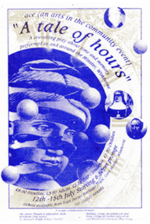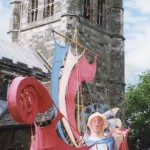Read a poem by Thomas Hardy about the Wimborne Minster Quarterjack
How smartly the quarters of the hour march by
That the jack-o’-clock never forgets …

 A Tale of Hours explores the mystery of time and memory.
A Tale of Hours explores the mystery of time and memory.
Young Jack is saddened that his grandmother, a woman who instilled in him a love of history, is losing her memory. Jack asks his father, a stonemason, working on the Minster, why memory seems to break through time barriers. ‘Where does the past go?’ he asks.
As he sits on the War Memorial his wonderings bring to life the Quarterjack, the Minster’s sentinel of time, who has rung the hours of the church clock for more than 400 years. Together they lead the audience on a journey around the Minster and meet real characters who once lived in Wimborne, Thomas Hardy, Isaac Gulliver (a famous Dorset smuggler), Lioba (one of the first nuns at the Saxon monastery at Wimborne), as well as a scientist, not unlike leading cosmologist, Stephen Hawking, who helps the boy rethink the conundrum of history and our place in the universe.

The play explored themes of Alzheimer’s Disease, memory (and loss of memory), time and space and the importance of the imagination. The histories of the Church of St Cuthburga and Wimborne Minster were also researched for this play. Local schools worked with regional artists and Dorset Theatre in Education.
1. Short extract from Scene 6: Ship of Memory.
Jack and the Quarterjack climb into the pulpit of Wimborne Minster and reflect on what they have seen on their adventures.
Lioba’s ship is carried down the aisle out on to the Minster Green.
2. BBC children’s programme Bitsa presented by environmental artists, Simon Pascoe and Caitlin Easterby from Red Earth, who produced the artwork for the play.
The programme features children from Wimborne First School working on the artefacts for the Smugglers’ Scene and the artists building the arch and constructing Lioba’s ship for the play. These are then shown in extracts from the production.
3. Preparation – informal scenes of the cast assembling as the finishing touches are put to the environmental structures on the Minster Green.
The second part of the video shows Scene 1: Time on the Minster Green.
The procession of characters enters singing and the Quarterjack introduces Jack and his Granny. The adventure begins.
4. Scene 2: At the Secret Meeting Place.
Isaac Gulliver’s smugglers meet to share out the latest haul of contraband, featuring children from Wimborne First School.
Read the Research Notes on the Notables in Wimborne Minster
With the exception of Thomas Hardy, all the notable historical characters featured in the play have tombs or memorials in the Minster.
Read a poem by Thomas Hardy about the Wimborne Minster Quarterjack
How smartly the quarters of the hour march by
That the jack-o’-clock never forgets …
 This sculpture depicts St Lioba sailing from England to the Frankish kingdom. Lioba was educated in Wimborne in the double monastery founded in 706 AD by Queen Cuthberga.
This sculpture depicts St Lioba sailing from England to the Frankish kingdom. Lioba was educated in Wimborne in the double monastery founded in 706 AD by Queen Cuthberga.
Boniface requested that Lioba and ten of her sisters should go to Germany as missionaries. She worked there for more than thirty years becoming Abbess of Bischofsheim.
Wimborne is twinned with Ochsensfurt which is in the area that Lioba and the Wimborne nuns worked.
The boat sculpture was made by Caitlin Easterby with Karina Horitz and Reuben Hart.
Read the lyrics of songs composed for the production by members of WCT